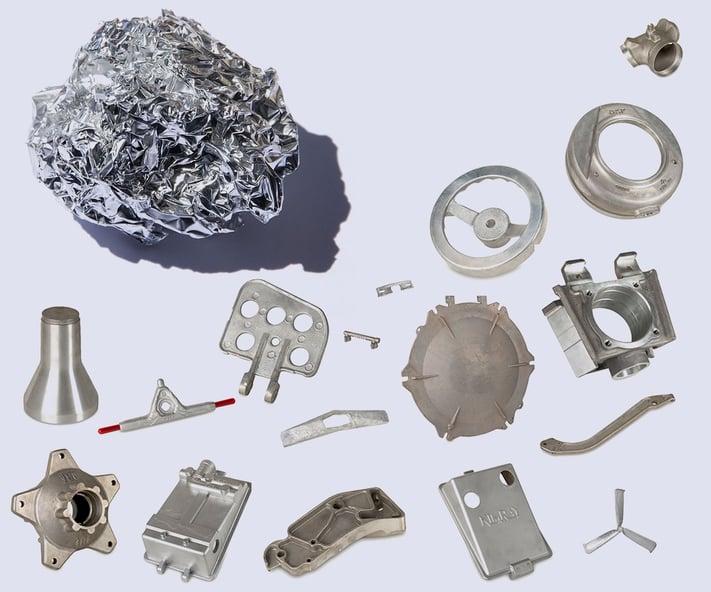Top Guidelines Of Aluminum Castings Company
Wiki Article
Unknown Facts About Aluminum Castings Company
Table of ContentsSome Of Aluminum Castings CompanySome Known Incorrect Statements About Aluminum Castings Company All About Aluminum Castings CompanyAluminum Castings Company for BeginnersThe 8-Minute Rule for Aluminum Castings CompanyGetting The Aluminum Castings Company To WorkNot known Incorrect Statements About Aluminum Castings Company The Best Guide To Aluminum Castings Company
There are 2 primary kinds of die casting used in the aluminum spreading sector: hot chamber die spreading and cold chamber pass away spreading. The primary difference in between these methods is just how the molten metal is delivered to the mold and mildew. In warm chamber die spreading, frequently utilized for reduced melting factor metals, the fusion is straight attached to the equipment, and a plunger compels the product via a gooseneck into the die tooth cavity.
The Single Strategy To Use For Aluminum Castings Company
In these methods, the mold and mildew is deliberately ruined or broken away in order to extract the finished aluminum spreading. Common procedures under the category of expendable mold and mildew casting consist of (financial investment casting),,, and financial investment spreading. When manufacturing customized aluminum components utilizing expendable molds, makers put liquified light weight aluminum or light weight aluminum alloys into the mold, which is after that busted apart to launch the solidified steel part.The is just one of the earliest and most favored types of light weight aluminum casting. It includes condensing specialty shop sand, commonly reinforced with clay or material, around a specifically crafted reusable pattern that figures out the shape and interior information of the finished aluminum product. The pattern system incorporates risers and vents to manage the flow of molten steel and to avoid casting flaws such as shrinkage porosity.
A Biased View of Aluminum Castings Company

This mold and mildew is then preheated prior to the pouring of liquified light weight aluminum or aluminum alloy. As the metal loads the shell, it catches the elaborate information and fine surface area coating of the mold and mildew. Once cooled, the ceramic is mechanically or chemically broken away, enabling the elimination and splitting up of specific cast components.
Not known Incorrect Statements About Aluminum Castings Company
Irreversible mold and mildew casting utilizes reusable metal mold and mildews and is excellent for automation with regular top quality and less waste. Expendable mold casting utilizes single-use mold and mildews, like sand or foam, using style flexibility and reduced tooling costs for prototypes or short runs. Die casting is best for creating high quantities of light weight aluminum components that call for tight tolerances, fine details, and smooth surfaces.The Toshiba Machine DC-J Series consists of die casting machines ideal for aluminum. Recognized for their robust building and high shot performance, these equipments ensure efficient and exact spreading (Metal Foundry).

While aluminum can be used in its pure form, it is typically alloyed with various other metals to boost its buildings or the homes of the other metals. These alloys provide enhanced performance for different applications. Aluminum alloys are categorized right into eight collection, phoned number from one to eight. The initial figure(s) of the number indicate the main alloying element integrated with light weight aluminum.
Some Ideas on Aluminum Castings Company You Should Know
This alloying boosts the stamina and hardness of light weight aluminum yet reduces its ductility and deterioration resistance. The 3000 collection alloys are primarily alloyed with manganese.The 4000 collection alloys are alloyed with silicon, which lowers the melting factor and enhances fluidness. This makes it a prominent choice for casting, as it is simple to develop in its molten state.
Examine This Report about Aluminum Castings Company
This collection is identified as a high-strength alloy, specifically matched for sheet and plate applications due to its exceptional weldability. Its resistance to deterioration from acids and alkalis makes it ideal for use in extreme and hostile environments (Aluminum Foundry). The 6000 series alloys are alloyed with both magnesium and silicon, offering an equilibrium of stamina, mechanical residential properties, and corrosion resistanceProcessing the 6000 series calls for specialized and advanced tools, which can be complex and costly. Nonetheless, this series is recognized for its superb rust and oxidation resistance, in addition to its simplicity of coating, treatment, and workability. The 7000 collection light weight aluminum alloys are the best and most long lasting amongst aluminum kinds, with toughness equivalent to about two-thirds of industrial-grade A3 steel.
8 Simple Techniques For Aluminum Castings Company
Zinc is the key alloying next element in the 7000 series, boosting the firmness of the light weight aluminum, even though zinc's hardness resembles that of aluminum on the Mohs range. The 8000 series aluminum alloys are largely alloyed with tin, together with percentages of copper and nickel (Sand Mold). While these alloys provide lower stamina compared to various other collection, they master machinability and use resistanceAluminum cast heatsinks are electrically conductive, allowing them to be grounded properly. They are typically cast with integrated features that reduce the demand for second operations, such as added machining or setting up, leading to further cost financial savings. Aluminum casting is often used to make brackets for both heavy-duty industrial tools and house appliances.
Aluminum Castings Company Fundamentals Explained
The single-piece building of aluminum braces enhances their strength and resilience, lowering the possibility of failing. If holes are needed, they can be included straight in the spreading mold, reducing the demand for post-production ending up (https://profile.hatena.ne.jp/alumnmcstngs/). Makers have increasingly adopted aluminum casting for golf devices as a result of its longevity, stability, and convenience in shapingReport this wiki page